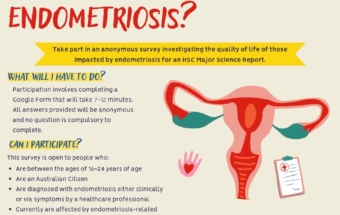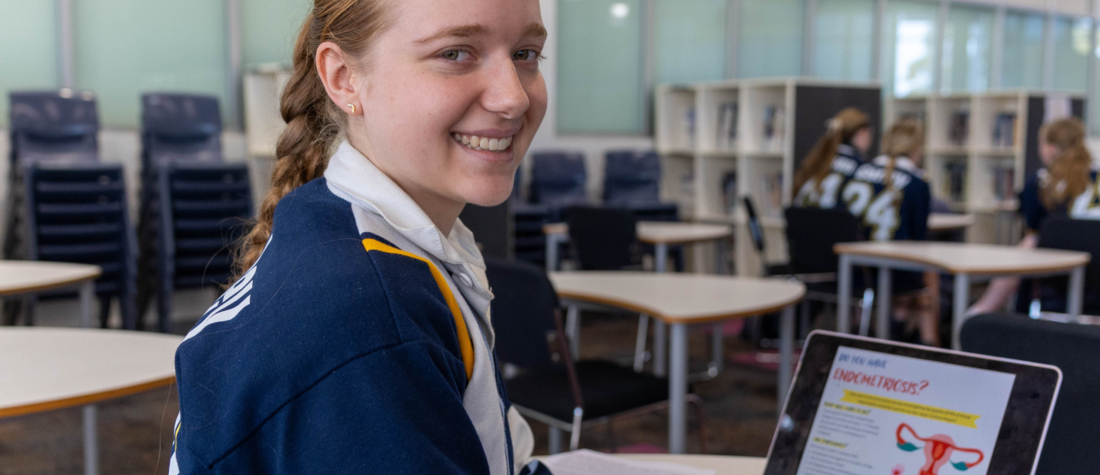It’s a disease that affects roughly one in ten Australian women, including teenage girls. But there has been very little scientific research on how endometriosis impacts adolescents, because there is a misconception that it only affects older women. Annabel, a Year 12 student, wants that to change. The World Health Organisation describes endometriosis as “a disease in which tissue similar to the lining of the uterus grows outside the uterus”, and symptoms vary between women. Annabel’s Science Extension research project is a survey of young women diagnosed with endometriosis, to gather data on how the disease has affected their quality of life. The Science Extension Research project allows students to showcase the habits of the STRIVE attribute of the Inaburra Learning Framework through planning, assessing, and persevering.
The first step of planning is deciding where you are going. Annabel knew she wanted to research women’s health. She decided to focus on endometriosis because it is a common disease but one that has only gained attention in the past few years. Annabel wants “to allow sufferers of endometriosis to have a voice in how it affects their quality of life.” Annabel decided to use an online survey, because this allows her to anonymously gather data on the endometriosis experiences of young women across Australia. Thinking strategically, Annabel is planning to open her survey in April, after Endometriosis Awareness Month in March, while the disease is still in people’s minds.
Planning means anticipating obstacles. Annabel is aware that her biggest challenge will be gathering a sample size large enough for her results to be accurate and reliable. To reach a wide audience Annabel plans to put her survey on four different Facebook groups for endometriosis sufferers, but there is also the problem that not many teenagers are on Facebook. Annabel is hopeful that word of mouth will lead to more responses, as her preparation has shown that the endometriosis community is keen to see more research on the disease.
Managing time and resources and working at capacity feel like second nature to most HSC students, and they are habits of the STRIVE attribute of the Inaburra Learner Framework. For students doing major HSC projects, these habits will carry through the duration of their project. “My time management has been the biggest challenge because it’s a marathon, it’s not something you can smash out in a weekend. It takes a lot of preparation and logistically planning and talking to experts.” To STRIVE also means to take calculated risks. Early in her research Annabel reached out and sought guidance from a University of Melbourne research team who were conducting their own endometriosis survey, which was a confronting step for a student in the first term of Year 12.
The Inaburra Learner Framework describes perseverance as building grit and determination by continuing in the face of difficulties. Annabel’s first difficulty came during her initial literature review, when she discovered that her idea to study different treatment options for endometriosis had already been investigated. “I realised it needed to be more niche, it needed to add something to the literature that hadn’t been done… And then I realised the need for research on adolescents.” Another challenge for Annabel has been writing questions that walk the fine line between needing data but not asking questions that are too personal for young women to feel comfortable answering. The STRIVE habit of assessing means adapting your process as you meet difficulties. Throughout her research Annabel has consulted with the Ethics Committee and her Science Extension teacher to adapt her survey to ensure her research meets ethical standards around informed consent and sensitivity to mental health.
Assessing a project also means seeing unexpected opportunities, and Annabel hopes that more research will lead to greater empathy towards women with endometriosis. Annabel’s research has given her experience of the scientific process of PhD research teams and has given her an insight into the work of women’s health professionals. She feels honoured by the opportunity to hear young women’s stories. “The end goal is for it to be a piece of literature that not only am I proud of, but also makes a difference in some way. I don’t mind if it just makes a difference to the people who participated, to feel like one person heard their story.”
Annabel would welcome any willing respondents to her survey, so if you are aged 16-24, have been diagnosed with endometriosis and would like to take part in the survey, please email adolescent.endo.research@gmail.com.


